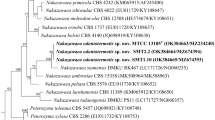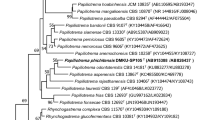Abstract
A set of four strains representing a novel basidiomycetous yeast species Rhodotorula sampaioana f. a., sp. nov. were isolated from two different habitats, subsurface waters of Lake Negra in Argentina, and the gut of a xylophagous termite in India. Phylogenetic analyses of LSU and ITS sequences showed that they belonged to the genus Rhodotorula of the order Sporidiobolales (subphylum Pucciniomycotina) and the closest known relative being R. kratochvilovae. The new species differed from R. kratochvilovae CBS 7436 (AF071436, AF444520) by nine nucleotide substitutions and one deletion (1.7 % sequence variation) in a 593 bp D1/D2 region, and by five nucleotide substitutions and three deletions (1.3 %) in a 592 bp ITS region, respectively. Several morphological and physiological differences were also observed between R. kratochvilovae and the strains obtained during this study. These data support the proposal of Rhodotorula sampaioana as a novel species, with CRUB 1124 as the holotype, CBS 10798 as ex-type, and NFCCI 4872 as an additional strain. The GenBank accession numbers of the LSU and ITS sequences of Rhodotorula sampaioana f. a., sp. nov. are EF595748 and MW879331. The MycoBank number is MB 838533.


Similar content being viewed by others
Availability of data and materials
All data generated or analysed during this study are included in this published article [and its supplementary information files]. The strains used in the present study are available at the Westerdijk Fungal Biodiversity Institute Utrecht, The Netherlands, and the National Fungal Culture Collection of India (NFCCI), India.
References
Aamir S, Sutar S, Singh SK, Baghela A (2015) A rapid and efficient method of fungal genomic DNA extraction, suitable for PCR based molecular methods. Plant Pathol Quarant 5:74–81. https://doi.org/10.5943/ppq/5/2/6
Barnett J, Payne R, Yarrow D (2000) Yeasts: characteristics and identification, 3rd edn. Cambridge University Press, Cambridge, p 1150
Brandão LR, Vaz AB, Santo LC et al (2017) Diversity and biogeographical patterns of yeast communities in the Antarctic, Patagonian and tropical lakes. Fungal Ecol 28:33–43. https://doi.org/10.1016/j.funeco.2017.04.003
Brugerolle G, Radek R, König H, Varma A (2006) Intestinal microorganisms of termites and other invertebrates. Springer 6:407–424. https://doi.org/10.1007/3-540-28185-1
Clark JW, Kambhampati S (2003) Phylogenetic analysis of Blattabacterium, endosymbiotic bacteria from the wood roach, Cryptocercus (Blattodea: Cryptocercidae), including a description of three new species. Mol Phylogenet Evol 26:82–88. https://doi.org/10.1016/S1055-7903(02)00330-5
Crous PW, Wingfield MJ, Burgess TI et al (2017) Fungal planet description sheets. Persoonia Molecular Phylogeny Evolut Fungi 38:558–624. https://doi.org/10.3767/003158517X698941
Edgar RC (2004) MUSCLE: Multiple sequence alignment with high accuracy and high throughput. Nucleic Acids Res 32:1792–1797. https://doi.org/10.1093/nar/gkh340
Fell JW, Statzell-Tallman A (1998) Rhodosporidium Banno. In: The Yeasts, A Taxonomic Study, 4th edn. Elsevier, Amsterdam, pp 678–692
Fonseca A (1992) Utilisation of tartaric acid and related compounds by yeasts: Taxonomic implications. Can J Microbiol 38:1242–1251. https://doi.org/10.1139/m92-205
Jones G, Southworth D, Libkind D, Marvanová L (2014) Freshwater Basidiomycota. In: Jones G, Hyde K, Pang K-L (eds) Freshwater fungi and fungus-like organisms. Walter de Gruyter GmbH & Co KG, Berlin/Boston, pp 73–108
Kijpornyongpan T, Aime MC (2017) Taxonomic revisions in the Microstromatales: two new yeast species, two new genera, and validation of Jaminaea and two Sympodiomycopsis species. Mycological Progress 16:495–505. https://doi.org/10.1007/s11557-017-1276-2
Kurtzman CP, Fell JW, Boekhout T, Robert V (2011) Methods for isolation, phenotypic characterisation and maintenance of yeasts. In: The Yeasts. Elsevier, Amsterdam, pp 87–110
Kurtzman CP, Robnett CJ (1998) Identification and phylogeny of ascomycetous yeasts from analysis of nuclear large subunit (26S) ribosomal DNA partial sequences. Antonie van Leeuwenhoek. Int J General Molecular Microbiol 73:331–371. https://doi.org/10.1023/A:1001761008817
Kurtzman CP, Robnett CJ (2003) Phylogenetic relationships among yeasts of the “Saccharomyces complex” determined from multigene sequence analyses. FEMS Yeast Res 3:417–432. https://doi.org/10.1016/S1567-1356(03)00012-6
Li AH, Yuan FX, Groenewald M et al (2020) Diversity and phylogeny of basidiomycetous yeasts from plant leaves and soil: Proposal of two new orders, three new families, eight new genera and one hundred and seven new species. Stud Mycol 96:17–140. https://doi.org/10.1016/j.simyco.2020.01.002
Libkind D (2011) Rhodotorula. In: Liu D (ed) Molecular detection of human fungal pathogens. CRC Press, Taylor & Francis Group, pp 653–667
Libkind D, Brizzio S, Ruffini A et al (2003) Molecular characterisation of carotenogenic yeasts from aquatic environments in Patagonia. Antonie Van Leeuwenhoek 84:313–322. https://doi.org/10.1023/A:1026058116545
Libkind D, Buzzini P, Turchetti B, Rosa CA (2017) Yeasts in continental and sea water. In: Buzzini P, Lachance MA, Yurkov A (eds) Yeasts in natural ecosystems: diversity. Springer, Cham, pp 1–61
Libkind D, Gadanho M, van Broock M, Sampaio JP (2005) Sporidiobolus longiusculus sp. nov. and Sporobolomyces patagonicus sp. nov., novel yeasts of the Sporidiobolales isolated from aquatic environments in Patagonia, Argentina. Int J Syst Evol Microbiol 55:503–509. https://doi.org/10.1099/ijs.0.63322-0
Libkind D, Moliné M, Sampaio JP, van Broock M (2009) Yeasts from high-altitude lakes: Influence of UV radiation. FEMS Microbiol Ecol 69:353–362. https://doi.org/10.1111/j.1574-6941.2009.00728.x
Mestre CM, Rosa CA, Safar SVB et al (2011) Yeast communities associated with the bulk-soil, rhizosphere and ectomycorrhizosphere of a Nothofagus pumilio forest in northwestern Patagonia, Argentina. FEMS Microbiol Ecol 78:531–541. https://doi.org/10.1111/j.1574-6941.2011.01183.x
Mestre MC, Fontenla S, Rosa CA (2014) Ecology of cultivable yeasts in pristine forests in northern Patagonia (Argentina) influenced by different environmental factors. Can J Microbiol 60:371–382. https://doi.org/10.1139/cjm-2013-0897
Moliné M, Libkind D, del Carmen Diéguez M, van Broock M (2009) Photoprotective role of carotenoids in yeasts: response to UV-B of pigmented and naturally-occurring albino strains. J Photochem Photobiol B 95:156–161. https://doi.org/10.1016/j.jphotobiol.2009.02.006
Moliné M, Arbeloa EM, Flores MR, Libkind D et al (2011) UVB photoprotective role of mycosporines in yeast: photostability and antioxidant activity of mycosporine-glutaminol-glucoside. Radiat Res 175:44–50. https://doi.org/10.1667/RR2245.1
Nguyen LT, Schmidt HA, von Haeseler A, Minh BQ (2015) IQ-TREE: A fast and effective stochastic algorithm for estimating maximum-likelihood phylogenies. Mol Biol Evol 32:268–274. https://doi.org/10.1093/molbev/msu300
Sampaio JP (2011) Rhodotorula Harrison (1928) In: The yeasts. A taxonomic study, 5th edn. Elsevier, Amsterdam, The Netherlands, pp 1873–1927
Sampaio JP (1999) Utilisation of low molecular weight aromatic compounds by heterobasidiomycetous yeasts: Taxonomic implications. Can J Microbiol 45:491–512. https://doi.org/10.1139/w99-020
Stefanini I (2018) Yeast-insect associations: It takes guts. Yeast 35:315–330. https://doi.org/10.1002/yea.3309
Tiwari S, Avchar R, Arora R, et al (2020) Xylanolytic and ethanologenic potential of gut associated yeasts from different species of termites from India. Mycobiology 48:501–511. https://doi.org/10.1080/12298093.2020.1830742
Vu D, Groenewald M, Szöke S et al (2016) DNA barcoding analysis of more than 9†1000 yeast isolates contributes to quantitative thresholds for yeast species and genera delimitation. Stud Mycol 85:91–105. https://doi.org/10.1016/j.simyco.2016.11.007
Wang QM, Groenewald M, Takashima M et al (2015a) Phylogeny of yeasts and related filamentous fungi within Pucciniomycotina determined from multigene sequence analyses. Stud Mycol 81:27–53. https://doi.org/10.1016/j.simyco.2015.08.002
Wang QM, Yurkov AM, Göker M et al (2015b) Phylogenetic classification of yeasts and related taxa within Pucciniomycotina. Stud Mycol 81:149–189. https://doi.org/10.1016/j.simyco.2015.12.002
White TJ, Bruns S, Lee S, Taylor J (1990) Amplification and direct sequencing of fungal ribosomal RNA genes for phyologenetics. PCR Protocols: A Guide to Methods and Applications pp 315–322
Yurkov AM, Kachalkin AV, Daniel HM, Groenewald M et al (2015) Two yeast species Cystobasidium psychroaquaticum fa sp. nov. and Cystobasidium rietchieii fa sp. nov. isolated from natural environments, and the transfer of Rhodotorula minuta clade members to the genus Cystobasidium. Antonie Van Leeuwenhoek 107:173–185. https://doi.org/10.1007/s10482-014-0315-0
Acknowledgements
We duly acknowledge the help extended by Dr Karthick Balasubramanian and Mr Rameshwar Avchar from Agharkar Research Institute, Pune, India. ST is thankful to the University Grants Commission, Delhi (India) for senior research fellowship [827/(CSIR-UGC NET DEC.2017)]. DL thanks the authorities of Administración de Parques Nacionales (Argentina) for providing sampling permits. This work was partially supported by CONICET (PIP11220130100392CO), and Universidad Nacional del Comahue (B199).
Funding
This study was supported by financial aid from Universidad Nacional del Comahue (Project B199) and CONICET (Project PIP424).
Author information
Authors and Affiliations
Contributions
Snigdha Tiwari: Sampling, Methodology, Formal analysis and Investigation, Data Curation, Writing- Original draft. Abhishek Baghela: Methodology, Data Curation, Resources, Supervision, Project administration, Writing– review and editing. Diego Libkind: Sampling, Methodology, Formal analysis and Investigation, Data Curation, Writing– Original draft, review and editing.
Corresponding authors
Ethics declarations
Conflicts of interest
The authors declare that there are no conflicts of interest.
Additional information
Publisher’s Note
Springer Nature remains neutral with regard to jurisdictional claims in published maps and institutional affiliations.
Supplementary Information
Rights and permissions
About this article
Cite this article
Tiwari, S., Baghela, A. & Libkind, D. Rhodotorula sampaioana f.a., sp. nov., a novel red yeast of the order Sporidiobolales isolated from Argentina and India. Antonie van Leeuwenhoek 114, 1237–1244 (2021). https://doi.org/10.1007/s10482-021-01597-5
Received:
Accepted:
Published:
Issue Date:
DOI: https://doi.org/10.1007/s10482-021-01597-5




